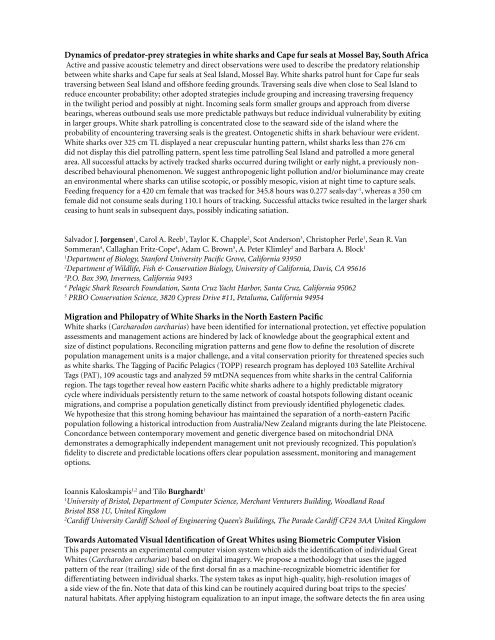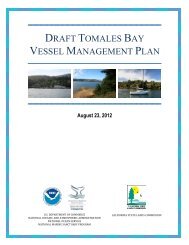Symposium program - Gulf of the Farallones National Marine ...
Symposium program - Gulf of the Farallones National Marine ...
Symposium program - Gulf of the Farallones National Marine ...
Create successful ePaper yourself
Turn your PDF publications into a flip-book with our unique Google optimized e-Paper software.
Dynamics <strong>of</strong> predator-prey strategies in white sharks and Cape fur seals at Mossel Bay, South Africa<br />
Active and passive acoustic telemetry and direct observations were used to describe <strong>the</strong> predatory relationship<br />
between white sharks and Cape fur seals at Seal Island, Mossel Bay. White sharks patrol hunt for Cape fur seals<br />
traversing between Seal Island and <strong>of</strong>fshore feeding grounds. Traversing seals dive when close to Seal Island to<br />
reduce encounter probability; o<strong>the</strong>r adopted strategies include grouping and increasing traversing frequency<br />
in <strong>the</strong> twilight period and possibly at night. Incoming seals form smaller groups and approach from diverse<br />
bearings, whereas outbound seals use more predictable pathways but reduce individual vulnerability by exiting<br />
in larger groups. White shark patrolling is concentrated close to <strong>the</strong> seaward side <strong>of</strong> <strong>the</strong> island where <strong>the</strong><br />
probability <strong>of</strong> encountering traversing seals is <strong>the</strong> greatest. Ontogenetic shifts in shark behaviour were evident.<br />
White sharks over 325 cm TL displayed a near crepuscular hunting pattern, whilst sharks less than 276 cm<br />
did not display this diel patrolling pattern, spent less time patrolling Seal Island and patrolled a more general<br />
area. All successful attacks by actively tracked sharks occurred during twilight or early night, a previously nondescribed<br />
behavioural phenomenon. We suggest anthropogenic light pollution and/or bioluminance may create<br />
an environmental where sharks can utilise scotopic, or possibly mesopic, vision at night time to capture seals.<br />
Feeding frequency for a 420 cm female that was tracked for 345.8 hours was 0.277 seals∙day -1 , whereas a 350 cm<br />
female did not consume seals during 110.1 hours <strong>of</strong> tracking. Successful attacks twice resulted in <strong>the</strong> larger shark<br />
ceasing to hunt seals in subsequent days, possibly indicating satiation.<br />
Salvador J. Jorgensen 1 , Carol A. Reeb 1 , Taylor K. Chapple 2 , Scot Anderson 3 , Christopher Perle 1 , Sean R. Van<br />
Sommeran 4 , Callaghan Fritz-Cope 4 , Adam C. Brown 5 , A. Peter Klimley 2 and Barbara A. Block 1<br />
1<br />
Department <strong>of</strong> Biology, Stanford University Pacific Grove, California 93950<br />
2<br />
Department <strong>of</strong> Wildlife, Fish & Conservation Biology, University <strong>of</strong> California, Davis, CA 95616<br />
3<br />
P.O. Box 390, Inverness, California 9493<br />
4<br />
Pelagic Shark Research Foundation, Santa Cruz Yacht Harbor, Santa Cruz, California 95062<br />
5<br />
PRBO Conservation Science, 3820 Cypress Drive #11, Petaluma, California 94954<br />
Migration and Philopatry <strong>of</strong> White Sharks in <strong>the</strong> North Eastern Pacific<br />
White sharks (Carcharodon carcharias) have been identified for international protection, yet effective population<br />
assessments and management actions are hindered by lack <strong>of</strong> knowledge about <strong>the</strong> geographical extent and<br />
size <strong>of</strong> distinct populations. Reconciling migration patterns and gene flow to define <strong>the</strong> resolution <strong>of</strong> discrete<br />
population management units is a major challenge, and a vital conservation priority for threatened species such<br />
as white sharks. The Tagging <strong>of</strong> Pacific Pelagics (TOPP) research <strong>program</strong> has deployed 103 Satellite Archival<br />
Tags (PAT), 109 acoustic tags and analyzed 59 mtDNA sequences from white sharks in <strong>the</strong> central California<br />
region. The tags toge<strong>the</strong>r reveal how eastern Pacific white sharks adhere to a highly predictable migratory<br />
cycle where individuals persistently return to <strong>the</strong> same network <strong>of</strong> coastal hotspots following distant oceanic<br />
migrations, and comprise a population genetically distinct from previously identified phylogenetic clades.<br />
We hypo<strong>the</strong>size that this strong homing behaviour has maintained <strong>the</strong> separation <strong>of</strong> a north-eastern Pacific<br />
population following a historical introduction from Australia/New Zealand migrants during <strong>the</strong> late Pleistocene.<br />
Concordance between contemporary movement and genetic divergence based on mitochondrial DNA<br />
demonstrates a demographically independent management unit not previously recognized. This population’s<br />
fidelity to discrete and predictable locations <strong>of</strong>fers clear population assessment, monitoring and management<br />
options.<br />
Ioannis Kaloskampis 1,2 and Tilo Burghardt 1<br />
1<br />
University <strong>of</strong> Bristol, Department <strong>of</strong> Computer Science, Merchant Venturers Building, Woodland Road<br />
Bristol BS8 1U, United Kingdom<br />
2<br />
Cardiff University Cardiff School <strong>of</strong> Engineering Queen’s Buildings, The Parade Cardiff CF24 3AA United Kingdom<br />
Towards Automated Visual Identification <strong>of</strong> Great Whites using Biometric Computer Vision<br />
This paper presents an experimental computer vision system which aids <strong>the</strong> identification <strong>of</strong> individual Great<br />
Whites (Carcharodon carcharias) based on digital imagery. We propose a methodology that uses <strong>the</strong> jagged<br />
pattern <strong>of</strong> <strong>the</strong> rear (trailing) side <strong>of</strong> <strong>the</strong> first dorsal fin as a machine-recognizable biometric identifier for<br />
differentiating between individual sharks. The system takes as input high-quality, high-resolution images <strong>of</strong><br />
a side view <strong>of</strong> <strong>the</strong> fin. Note that data <strong>of</strong> this kind can be routinely acquired during boat trips to <strong>the</strong> species’<br />
natural habitats. After applying histogram equalization to an input image, <strong>the</strong> s<strong>of</strong>tware detects <strong>the</strong> fin area using







